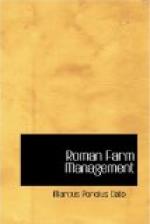ANOTHER CALENDAR OF SIX AGRICULTURAL SEASONS
“There is another division of the year,” said Stolo, “which takes account of both the sun and the moon, namely: into six seasons, because almost all the cultivated fruits of the earth come to maturity and reach the vat or the granary after five successive agricultural operations and are put to use by a sixth, and these are, first, the preparing (praeparandum); second, the planting (serendum); third, the cultivating of the growing crop (nutricandum); fourth, the ingathering (legendum); fifth, the storing (condendum), and sixth, the consuming (promendum).”
1 deg. PREPARING TIME
Of tillage
In the matter of preparation there are different things to be done for different crops, as, if you wish to make an orchard or an arbustum, you trench and grub and plough; if you plant grain, you plough and harrow; while, if you cultivate trees, you mulch their roots by breaking the earth with a mattock, more or less according to the nature of the tree, for some trees, like the cypress, have a small, and others like the plane tree have a large, root system (for example, that in the Lyceum at Athens described by Theophastus, which, when it was still a young tree, had a spread of roots to the extent of 33 cubits). If you break the ground with a plough and cattle, it is well to work the land a second time before you sow your seed. So, if you are making a meadow the preparation is to close it to the stock, and this is usually done when the pear tree is in bloom: if it is an irrigated meadow the preparation is to turn in the water at the proper time.
Of manuring
XXXVIII. As part of this same operation should be considered what places in a field need manure and what kind of manure you can use to the greatest advantage, for the several kinds have different qualities. Cassius says that the best manure is that of birds, except swamp and sea birds,[89] but the best of all is, he claims, the manure of pigeons because it is the hottest and causes the land to ferment. This ought to be sown on the land like seed, not distributed in heaps like the dung of cattle. I myself think the best manure is that from aviaries in which thrushes and blackbirds are kept, because it is not only good for the land but serves as a fattening food for cattle and hogs: for which reason those who farm aviaries pay less rent when the owner stipulates that the manure is to be used on the farm, than those to whom it is a perquisite. Cassius advises that the manure next in value to that of doves is human feces, and third that of goats and sheep and asses. The manure of horses is of the least value on corn land, but on meadows it is the best, because, like the manure of other draught animals fed on barley, it brings a heavy stand of grass. The manure pit should be near the barn in order that it may be available with the least labour. If you plant a stake of oak wood in the manure pit it will not harbour serpents.




